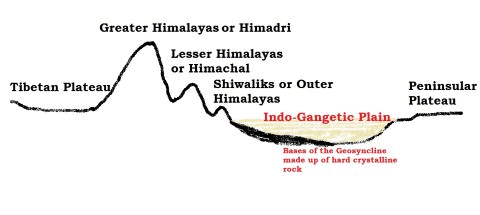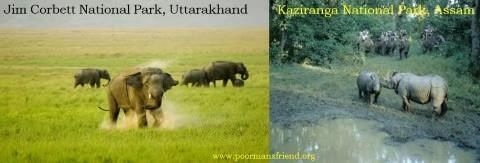UPSC Exam > UPSC Notes > Geography for UPSC CSE > Indo Gangetic Brahmaputra Plain
Indo Gangetic Brahmaputra Plain | Geography for UPSC CSE PDF Download
Formation of Indo – Gangetic – Brahmaputra Plain
- The formation of Indo-Gangetic plain is closely related to the formation of Himalayas.

Formation of Indo – Gangetic – Brahmaputra trough
- Before the Indian Plate collided with the Eurasian Plate, rivers deposited a vast amount of sediment in the Tethys Geosyncline, a large depression, where they flowed into the Tethys Sea.
- The collision of the Indian Plate with the Eurasian Plate led to the formation of the Himalayas, involving the uplift and compression of these sediments.
- Additionally, the northward movement of the Indian Plate created a trough south of the newly formed Himalayas.
Depositional Activity
- During the initial stages of upliftment of sediments, the already existing rivers changed their course several times and they were rejuvenated each time (perpetual youth stage of rivers {Fluvial Landforms}).
- The rejuvenation is associated with intense headward and vertical downcutting of the soft strata overlying the harder rock stratum.
- Headward erosion and vertical erosion of the river valley in the initial stages, lateral erosion in later stages contributed huge amount of conglomerates (detritus)(rock debris, silt, clay etc.) which were carried downslope.
- [Head ward erosion == Erosion at the origin of a stream channel, which causes the origin to move back away from the direction of the stream flow, and so causes the stream channel to lengthen]
- These conglomerates were deposited in the depression (Indo-Gangetic Trough or Indo-Gangetic syncline) (the base of the geosyncline is a hard crystalline rock) between peninsular India and the convergent boundary (the region of present day Himalayas).
New rivers and more alluvium
- The raising of Himalayas and subsequent formation of glaciers gave rise to many new rivers. These rivers along with glacial erosion {Glacial Landforms}, supplied more alluvium which intensified the filling of the depression.
- With the accumulation of more and more sediments (conglomerates), the Tethys sea started receding.
- With passage of the time, the depression was completely filled with alluvium, gravel, rock debris (conglomerates) and the Tethys completely disappeared leaving behind a monotonous aggradational plain.
- [monotonous == featureless topography; aggradational plain == plain formed due to depositional activity. Indo-Gangetic plain is a monotonous aggradational plain formed due to fluvial depositions].
- Upper peninsular rivers have also contributed to the formation of plains, but to a very small extent.
- During the recent times (since few million years), depositional work of three major river systems viz., the Indus, the Ganga and the Brahmaputra have become predominant.
- Hence this arcuate (curved) plain is also known as Indo-Gangetic-Brahmaputra Plain.

Features of Indo – Gangetic – Brahmaputra Plain
- Indo-Gangetic-Brahmaputra Plain is the largest alluvial tract of the world.
- It stretches for about 3,200 km from the mouth of the Indus to the mouth of the Ganga. Indian sector of the plain accounts for 2,400 km.
- The northern boundary is well marked by the Shiwaliks and the southern boundary is a wavy irregular line along the northern edge of the Peninsular India.
- The western boarder is marked by Sulaiman and Kirthar ranges. On the eastern side, the plains are bordered by Purvanchal hills.
- The width of the plain varies from region to region. It is widest in the west where it stretches for about 500 km. Its width decreases in the east.
- The thickness of the alluvium deposits also vary from place to place. The maximum depth of the alluvium up to the basement rocks is about 6,100 m (not uniform and varies greatly from place to place).
- The cones or alluvial fans of Kosi in the north and those of Son in the south exhibit greater alluvial thickness while the intra-cone areas have relatively shallower deposits.
- Extreme horizontality of this monotonous plain is its chief characteristic.
- Its average elevation is about 200 m above mean sea level, highest elevation being 291 m above mean sea level near Ambala (This elevation forms the drainage divide or watershed between Indus system and Ganga system).
- Its average gradient from Saharanpur to Kolkata is only 20 cm per km and it decreases to 15 cm per km from Varanasi to the Ganga delta.
Question for Indo Gangetic Brahmaputra PlainTry yourself: What is the average elevation of the Indo-Gangetic-Brahmaputra Plain?View Solution
Geomorphological features of Indo – Gangetic – Brahmaputra Plain
The Bhabar
- It is a narrow, porous, northern most stretch of Indo-Gangetic plain.
- Width and Location: It is about 8-16 km wide running in east-west direction along the foothills (alluvial fans) of the Shiwaliks. They show a remarkable continuity from the Indus to the Tista.
- Formation: Rivers originating from the Himalayas deposit their sediment along the foothills, forming alluvial fans, which combine to create the Bhabar belt.
- Porosity: The porosity of bhabar is the most unique feature. The porosity is due to deposition of huge number of pebbles and rock debris across the alluvial fans. The streams disappear once they reach the bhabar region because of this porosity. Therefore, the area is marked by dry river courses except in the rainy season.
- The Bhabar belt is comparatively narrow in the east and extensive in the western and north-western hilly region.
- Agricultural Viability: The Bhabar belt is unsuitable for agriculture due to its dry conditions, with only large-rooted trees able to thrive. The belt is wider in the western and northwestern regions and narrower in the east.
The Terai
- Location and Characteristics: The Terai is a wet, marshy, and densely forested strip located south of the Bhabar belt, running parallel to it. This region is approximately 15 to 30 kilometers wide.
- Underground Streams: In the Terai, underground streams that originate from the Bhabar belt re-emerge, contributing to the region's high moisture levels.
- Wildlife and Conservation: The Terai is known for its rich biodiversity and is home to several national parks, including Jim Corbett National Park in Uttarakhand and Kaziranga National Park in Assam, which are famous for their wildlife.

- Agricultural Development: Much of the Terai land, especially in Punjab, Uttar Pradesh, and Uttarakhand, has been converted into agricultural fields due to its fertile soil, producing good crops of sugarcane, rice, and wheat.
The Bhangar
- The Bhangar is characterized by older alluvium found along river beds, forming terraces that are higher than the surrounding flood plain.
- Calcareous Concretions: The terraces in the Bhangar often contain calcareous concretions known as 'KANKAR,' which are hardened deposits of calcium carbonate.
- Regional Variations: Regional variations of Bhangar include 'The Barind plains' in the deltaic region of Bengal and 'bhur formations' in the middle Ganga and Yamuna Doab regions.
- Fossil Findings: The Bhangar is known for containing fossils of large animals such as rhinoceros, hippopotamus, and elephants, indicating a rich prehistoric fauna.
The Khadar
- The Khadar is composed of newer alluvium and forms the flood plains along the river banks.
- A new layer of alluvium is deposited by river flood almost every year.
- This makes them the most fertile soils of Ganges.
Reh or Kollar
- Reh or Kollar comprises saline efflorescences of drier areas in Haryana.
- Reh areas have spread in recent times with increase in irrigation (capillary action brings salts to the surface).
The document Indo Gangetic Brahmaputra Plain | Geography for UPSC CSE is a part of the UPSC Course Geography for UPSC CSE.
All you need of UPSC at this link: UPSC
|
263 videos|875 docs|232 tests
|
FAQs on Indo Gangetic Brahmaputra Plain - Geography for UPSC CSE
| 1. What is the formation of the Indo-Gangetic-Brahmaputra Plain? |  |
Ans. The Indo-Gangetic-Brahmaputra Plain was formed through the deposition of sediments brought by the rivers Indus, Ganges, and Brahmaputra over millions of years. These rivers originate from the Himalayas and deposit their sediments in the plain, gradually building up the flat and fertile landscape.
| 2. What are the main features of the Indo-Gangetic-Brahmaputra Plain? |  |
Ans. The Indo-Gangetic-Brahmaputra Plain is characterized by its vastness, flatness, and fertility. It stretches across northern India, eastern Pakistan, and Bangladesh. The plain is intersected by numerous rivers and tributaries, forming an extensive network of waterways. It is also known for its alluvial soil, which is highly fertile and suitable for agriculture.
| 3. What are some of the geomorphological features of the Indo-Gangetic-Brahmaputra Plain? |  |
Ans. The Indo-Gangetic-Brahmaputra Plain exhibits several geomorphological features. These include river channels, floodplains, natural levees, oxbow lakes, and meanders. The plain also experiences frequent flooding due to the large amount of water brought by the rivers during the monsoon season.
| 4. How did the Indo-Gangetic-Brahmaputra Plain contribute to the development of human civilization in the region? |  |
Ans. The Indo-Gangetic-Brahmaputra Plain's fertile soil and abundant water resources have played a crucial role in the development of human civilization in the region. The plain has supported agricultural practices for thousands of years, allowing the growth of crops like rice, wheat, and sugarcane. This agricultural abundance has supported large populations and facilitated the establishment of ancient civilizations like the Indus Valley Civilization and the Vedic civilization.
| 5. What are some of the challenges faced by the Indo-Gangetic-Brahmaputra Plain? |  |
Ans. The Indo-Gangetic-Brahmaputra Plain faces several challenges, including overpopulation, water pollution, and soil degradation. The high population density puts pressure on the limited resources of the region, leading to issues like overcrowding, inadequate infrastructure, and environmental degradation. Additionally, industrial and agricultural activities contribute to the pollution of rivers and groundwater, affecting both human and ecological health. Soil degradation, caused by improper land management practices, also poses a threat to the long-term sustainability of agriculture in the plain.
Related Searches

















